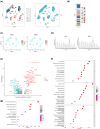Single-nucleus RNA sequencing reveals ARHGAP28 expression of podocytes as a biomarker in human diabetic nephropathy
- PMID: 40181839
- PMCID: PMC11967489
- DOI: 10.1515/med-2025-1146
Single-nucleus RNA sequencing reveals ARHGAP28 expression of podocytes as a biomarker in human diabetic nephropathy
Abstract
Introduction: Diabetic kidney disease (DKD) represents serious diabetes-associated complications, and podocyte loss is an important histologic sign of DKD. The cellular and molecular profiles of podocytes in DKD have yet to be fully elucidated.
Methods: This study analyzed kidney-related single-nucleus RNA-seq datasets (GSE131882, GSE121862, and GSE141115) and human diabetic kidney glomeruli transcriptome profiling (GSE30122). ARHGAP28 expression was validated by western blot and immunohistochemistry.
Results: In human kidney tissues, 154 differentially expressed genes (DEGs) were identified in podocytes, which were enriched in biological processes related to nephron development and extracellular matrix-receptor interactions. Similarly, in the mouse kidney, 344 DEGs were found, clustering in pathways associated with renal development and signaling mechanisms like PI3K/Akt (phosphatidylinositol-3 kinase/protein kinase B) and PPAR (peroxisome proliferator-activated receptor). In diabetic human kidney glomeruli, 438 DEGs were identified, showing significant enrichment in pathways related to diabetic nephropathy. Venn analysis revealed 22 DEGs common across human and mouse podocytes and diabetic glomeruli, with ARHGAP28 being notably overexpressed in podocytes. The diabetic nephropathy model using db/db mice showed that ARHGAP28 expression was significantly upregulated in the kidney cortex and glomeruli. In vitro studies using a high-glucose podocyte model corroborated these findings.
Conclusions: Collectively, this study provides an insight into the function and diagnosis of DKD and indicates that ARHGAP28 in podocytes is a potential biomarker of DKD.
Keywords: ARHGAP28; diabetic kidney disease, DKD; podocyte; single-nucleus RNA sequencing, snRNA-seq.
© 2025 the author(s), published by De Gruyter.
Conflict of interest statement
Conflict of interest: The authors declare that they have no competing interests.
Figures






References
-
- Deng L, Shi C, Li R, Zhang Y, Wangc X, Cai G, et al. The mechanisms underlying Chinese medicines to treat inflammation in diabetic kidney disease. J Ethnopharmacol. 2024;7:118424. - PubMed
LinkOut - more resources
Full Text Sources
Miscellaneous
